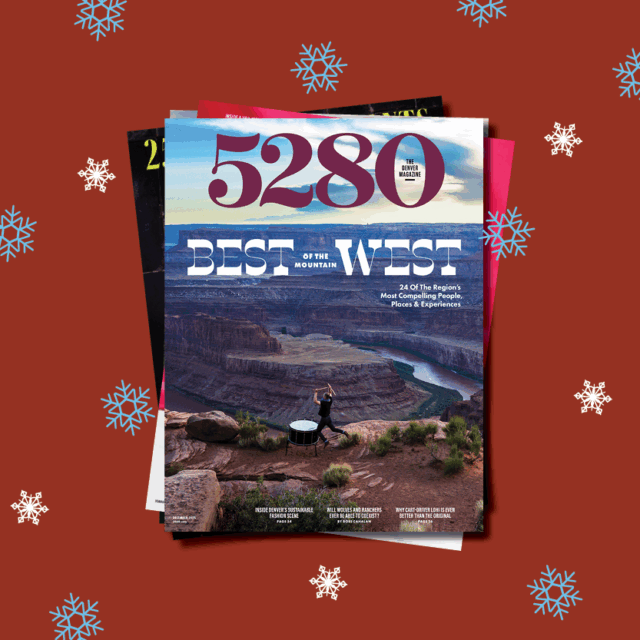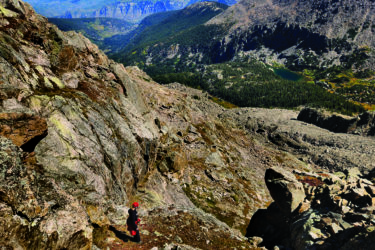The Local newsletter is your free, daily guide to life in Colorado. For locals, by locals.
Joe Rovere has been playing disc golf for 17 years and teaching for two decades—longer than some of the pros he now competes against have been alive. The 44-year-old father of two continues to be a dominant force on the tournament circuit, however, with a win percentage over 50 percent. That count includes the 2022 PDGA Masters Disc Golf World Championships in July and this past June’s High Plains Challenge in Fort Morgan, where Rovere took the $2,000 top prize plus a $1,000 bonus from his sponsor, Innova. “I made as much in a weekend,” Rovere says, “as I make in a month of teaching.”

The educator’s competitive drive probably can’t be taught. What he can explain is the S-curve flight pattern of discs, which are designed to fly differently, and farther, than Frisbees. There are many factors—from the weight and style of the disc to wind to arm speed—that affect the trajectory. But basically, if a right-handed person throws a backhand (the most common throw) and releases the disc flat, rotating clockwise, “it should turn to the right a little bit—that’s called turn,” Rovere says. “Then, it’ll hold that angle and ride straight. That’s your glide. At the very end of the flight, it’ll fade left.”

The best way to grasp the S-curve concept is practical application. Step one: Head for an open field with a lightweight fairway driver. Step two: Find a comfortable grip, with your thumb atop the disc and your fingers curled together underneath. Step three: With your right foot forward, standing perpendicular to your (imaginary) target, bring the disc across your chest, extend your arm, and release.
If you don’t get a smooth S-curve, don’t despair. YouTube has no shortage of how-to videos on footwork, body mechanics, altering a disc’s flight to get around obstacles by adding vertical and/or horizontal tilt, and mastering other throws, such as a forehand or overhead. Still struggling? It could be you need a different disc (see more below). If all that fails, Rovere did share one insight for your mental game: “When I lie in bed at night, I always go through courses in my head as I’m trying to fall asleep.”
What The Numbers on Discs Actually Mean
Thrown flat, most discs follow an S-curve, but how exaggerated each part of that trajectory will be depends greatly on the disc’s design. Almost every model on the market is labeled with a standard set of four numbers*—in order of speed, glide, turn, and fade—that tell you how it is meant to fly under optimal conditions. The following breakdown is based on a right-handed person throwing backhand; if you’re left-handed, all directions are mirrored.

Speed: From 1 to 14, these numbers represent the speed you must generate for the disc to fly the way it’s supposed to. (As in, you don’t have to throw a 1 very hard to get it to turn and fade correctly, but a 14 requires a lot of power to achieve its intended path.) Discs with lower speed ratings are easier to control, which can be beneficial for beginners, but they may not go as far.
Glide: Glide, rated from 1 to 7, indicates a disc’s ability to stay aloft. Discs with higher glide ratings will soar without much effort; those with lower glide ratings will come down more reliably (helpful if there is, say, a drop-off or body of water behind the basket).
Turn: When a disc gets up to speed, it wants to turn to the right. Labeled from +1 to -5, discs with higher numbers fly straighter/indicate less turn, which is desirable if you’re throwing into a headwind that’s going to force extra turn on your disc (pushing it too far to the right).
Fade: Classified from 0 to 5, fade describes the end of a disc’s flight. A higher number equals a stronger fade/harder pull to the left—also good for combating headwind.
*Adding a disc’s turn and fade ratings together provides a fifth number that is informally but frequently used to quantify stability. A stable disc, 0, flies relatively straight. Understable discs (negative numbers) turn to the right; overstable discs (positive numbers) resist the right turn and fade hard left at the end. Overstable discs are not recommended for beginners.








